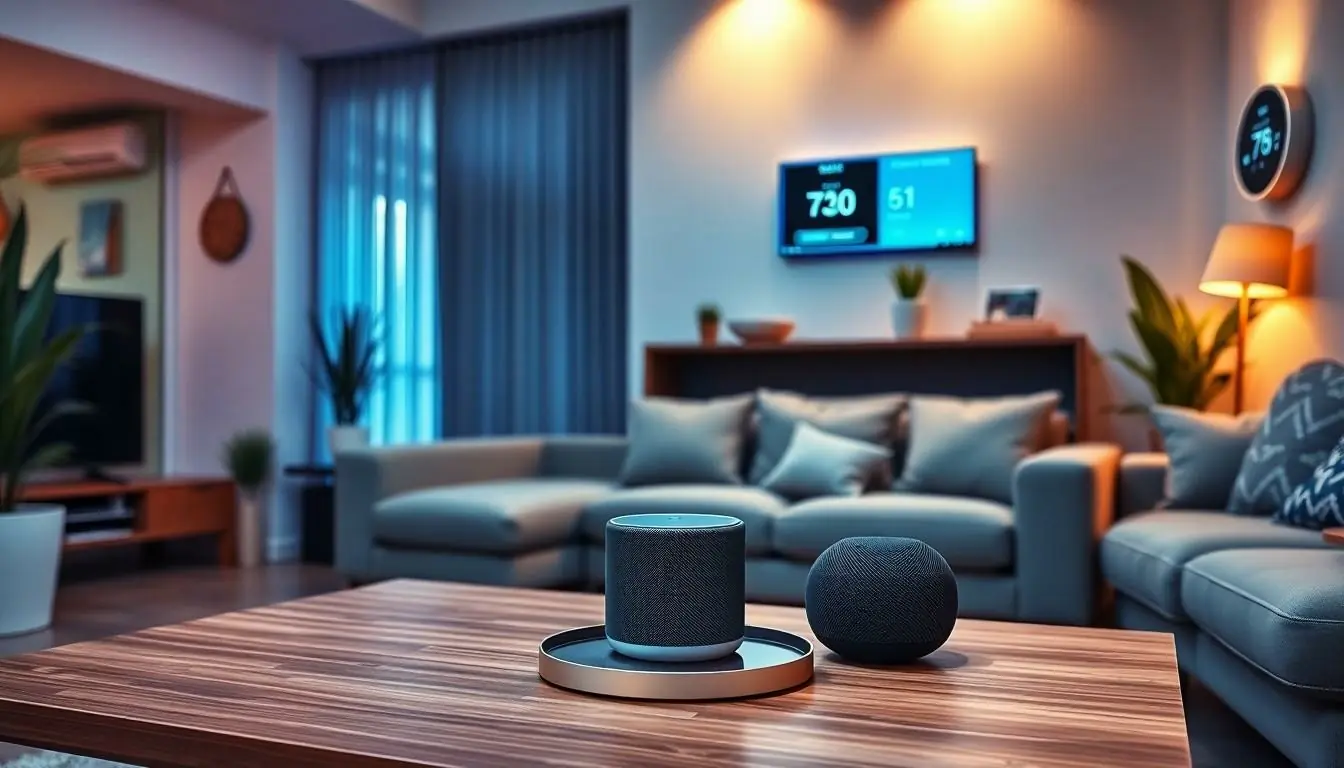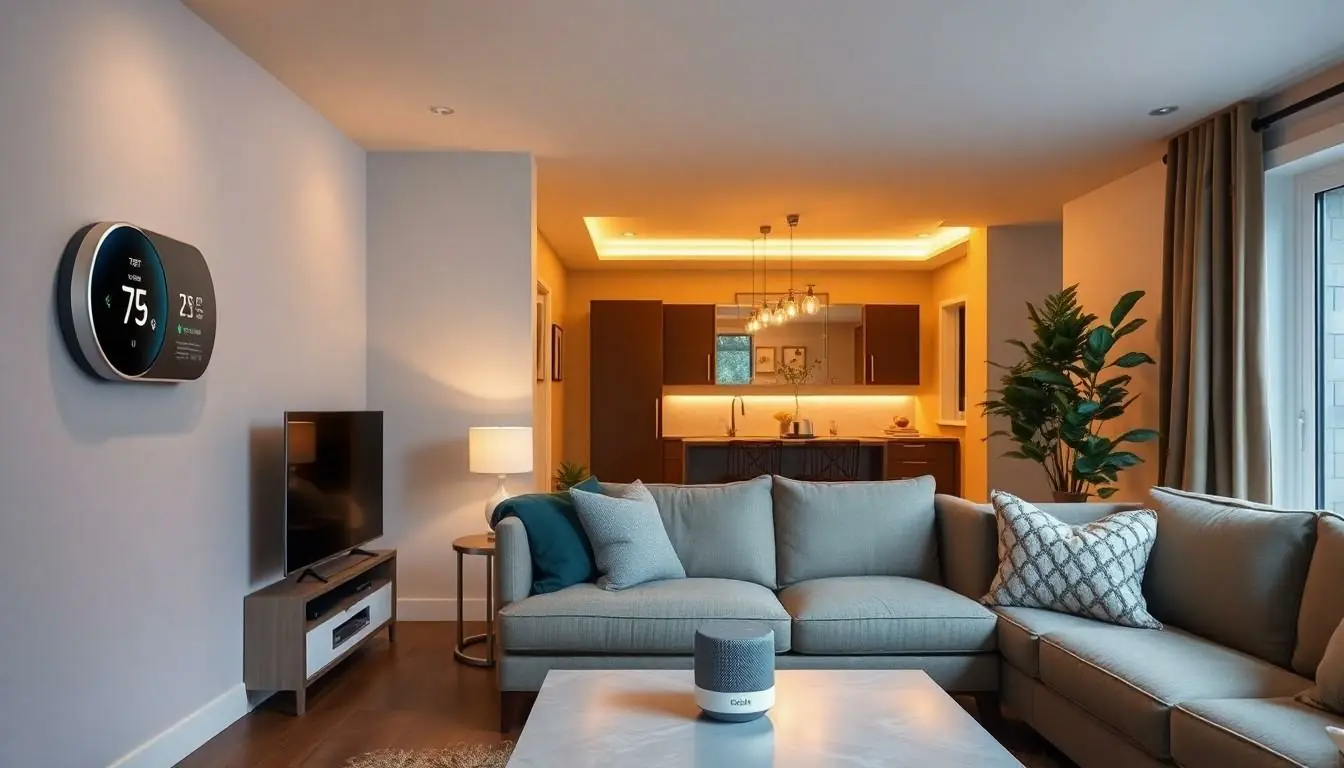Imagine waking up to the smell of freshly brewed coffee without lifting a finger. Sounds like magic, right? Welcome to the world of smart homes, where convenience meets innovation in a delightful dance. With a tap on your smartphone or a simple voice command, you can control everything from your lights to your thermostat, transforming your living space into a personal oasis of comfort and efficiency.
Table of Contents
ToggleOverview of Smart Home Technology
Smart home technology integrates devices within a home to enhance convenience and efficiency. Users control these devices through smartphones, tablets, or voice assistants. Systems include lighting, climate control, security cameras, and smart appliances. Each device communicates via a network, often connected to the internet.
Home automation offers significant benefits. Energy management allows users to monitor and reduce energy consumption effectively, leading to lower utility bills. Smart thermostats adjust temperatures based on user habits, optimizing comfort while saving energy. Security features include smart locks and surveillance cameras that provide real-time alerts and remote monitoring.
Interconnectivity stands out in smart home technology. Devices often work in harmony, allowing for customized routines. For example, a user can set a morning routine that gradually brightens lights while adjusting the thermostat and brewing coffee. These routines simplify daily tasks, enhancing overall quality of life.
A wide range of smart devices is available on the market. Popular brands offer everything from smart lights to full security systems. Choosing compatible devices ensures seamless integration, making a smart home more functional and user-friendly.
Standards for smart home technology promote interoperability. Protocols like Zigbee and Z-Wave allow devices from different manufacturers to communicate effectively. Users benefit from a more versatile setup that suits their preferences and needs.
Investing in smart home technology provides both immediate comforts and long-term benefits. Enhanced security, energy efficiency, and convenience contribute to an enriching home experience, making it a valuable addition for modern living.
Key Advantages of Smart Homes

Smart homes provide significant benefits that transform everyday living. These advantages enhance comfort, efficiency, and security, making modern life easier and safer.
Enhanced Convenience and Automation
Smart devices simplify daily tasks. Automating lighting, heating, or appliance control creates a seamless living experience. Homeowners can schedule routines like turning on lights at sunset or adjusting the thermostat remotely. Voice commands make it even easier to interact with devices, creating an intuitive environment. Smart home ecosystems streamline functionality across various devices. These systems integrate everything from smart speakers to appliances, allowing homeowners to manage their spaces effortlessly.
Energy Efficiency and Cost Savings
Optimizing energy usage is a key benefit of smart homes. Smart thermostats automatically adjust heating and cooling based on user habits, leading to substantial energy savings. The ability to monitor energy consumption in real time empowers homeowners to make informed decisions. These systems track usage patterns and provide suggestions for reducing waste. Consequently, lower utility bills result from smart technology that efficiently manages resources while maintaining comfort.
Improved Security Features
Smart home technology enhances security significantly. Surveillance cameras offer real-time monitoring and alerts for unusual activity, improving overall safety. Smart locks enable remote access control, allowing users to grant entry to guests or service people without being home. Additionally, motion sensors can trigger notifications for potential intruders, providing peace of mind. Integrating security systems with lighting helps deter break-ins by simulating occupancy. With these features, homeowners experience heightened security and greater control over their environments.
Popular Smart Home Devices
Smart home devices enhance convenience, security, and energy efficiency. Owners can choose from a wide range of innovative solutions that fit their lifestyle and preferences.
Smart Thermostats
Smart thermostats automate temperature control in homes. They learn user habits to optimize heating and cooling efficiently. Energy reports provide insights into usage patterns, helping homeowners save on bills. Popular models, like the Nest Learning Thermostat, adjust settings based on occupancy. Smart thermostats integrate well with other devices, allowing centralized control through apps or voice commands.
Smart Security Systems
Smart security systems protect homes with advanced technology. These systems include surveillance cameras, smart locks, and motion sensors. Homeowners receive real-time alerts on their smartphones if an event occurs. Some cameras offer features like facial recognition and two-way audio. Many systems support remote access control, allowing users to secure their property from anywhere.
Smart Lighting Solutions
Smart lighting solutions offer customized illumination and energy efficiency. Users can control bulbs remotely through apps or voice commands. Adjusting brightness and color temperature enhances comfort and ambiance. Scheduling features ensure lights activate or deactivate based on routines. Popular brands like Philips Hue provide a variety of smart bulbs that seamlessly integrate with compatible devices.
Challenges and Considerations
Smart homes offer incredible advantages, but potential challenges warrant attention. Users must navigate privacy, security, and cost-related aspects before investing in smart home technology.
Privacy and Security Concerns
Privacy risks arise as smart devices collect user data, creating potential vulnerabilities. Hackers may exploit these devices to gain unauthorized access, leading to breaches. Encryption and robust security measures protect sensitive information, yet they require constant updates. Smart home users must stay informed about device vulnerabilities and application permissions. An unprotected network opens avenues for cyberattacks, making it vital to secure Wi-Fi networks with strong passwords. Regularly reviewing privacy settings on devices plays a critical role in minimizing exposure. Taking these precautions enables homeowners to enjoy their smart environments with greater confidence.
Initial Investment and Setup Costs
Initial investment amounts can be significant when establishing a smart home. Smart devices, while offering long-term savings, often feature higher price points compared to traditional options. The cost of compatible devices from different manufacturers can add up quickly. Setup expenses, including installation and possible upgrades to home networks, must also be considered. For example, a smart thermostat may cost $150 to $250, while security systems can range from $200 to $1,000 or more. Budget planning and research help users find cost-effective solutions. Balancing upfront costs against potential energy savings and increased property value proves essential in making an informed decision.
Smart home technology represents a significant leap toward modern living. It streamlines daily activities while enhancing security and energy efficiency. By integrating various devices into a cohesive system, homeowners can enjoy unparalleled convenience and control over their environments.
While there are challenges such as privacy concerns and initial costs, the long-term benefits often outweigh these drawbacks. Investing in smart home solutions can lead to substantial savings on utility bills and increased property value. As technology continues to evolve, embracing smart home innovations can transform any living space into a more comfortable and efficient haven.





